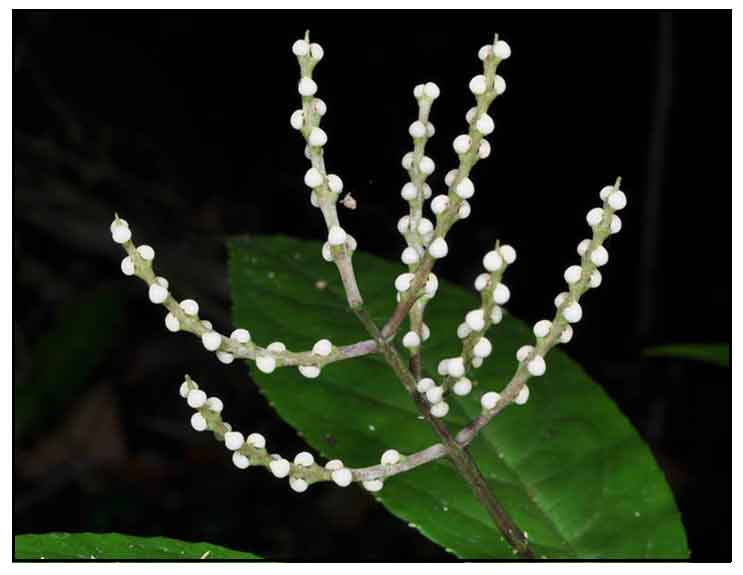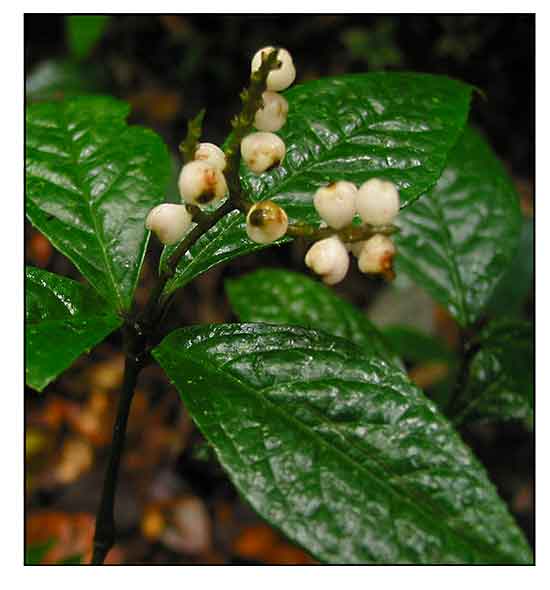
Gen info
- Chloranthus is a genus of flowering plants in the family Chloranthaceae. It is the type genus of its family, consisting of perennial herbs or evergreen shrubs.
- All plant parts can be used to make tea.
- In the 19th century the Dutch colonial government prohibited the cultivation of Chloranthus in Indonesia, in order to promote the planting and production of tea (Camellia sinensis). Since Chloranthus lost its popularity as a beverage, it is not difficult to find dried material of "keras tulang" on the market. (16)
Botany
• Barau-barau is a spreading undershrub, growing up to 2 meters tall, with a similar habit to apot (Chloranthus glabra). Stems are 30 to 70 centimeters high. Leaves are smooth, obovate-oblong or elliptic, the smaller ones broadly lanceolate, averaging 10 to 15 centimeters long, the larger ones being about 5 centimeters wide, with pointed tip, finely granular margin and with short stalks. Spikes are about 3 centimeters long, in few-branched terminal panicles, upon a 3- to 5-centimeter long peduncle. Flowers are white and small. Fruit is green when young, white o maturity, obovoid, juicy, 5 to 8 millimeters in diameter, with a relatively large seed.
 • Chloranthus erectus is a glabrous, aromatic, slightly woody herb or small shrub up to 3 m tall; nodes swollen, sometimes purplish. Leaves decussately opposite; petiole 1-1.5 cm long; stipules small, subulate; blade oblong-lanceolate to elliptical or ovate-oblong, 8-29 cm × 3-13 cm, base cuneate, margin shallowly glandular-serrate, apex long acuminate, penninerved, bright green, glossy above. Inflorescence a terminal, peduncled panicle consisting of 5-13 spikes 2.5-5 cm long; bracts sheathing, ovate, acute; flowers much reduced, without perianth, bisexual; the male part a 3-lobed organ (fused stamens?) adnate to the upper half of the ovary, 1.2-1.6 mm long, with 3 anthers, median one 2-locellate, lateral ones 1-locellate, yellow, greenish-white or violet-white; the female part composed of a 1-locular ovary with a single ovule, partly enclosed by the male part, stigma subsessile, truncate. Fruit a drupe, subglobose or ellipsoid, 5-7 mm in diameter, fleshy, white-cream or rarely tinged violet or pinkish, glossy. Seed subglobose, yellow-white, minutely apiculate, narrow below, surrounded by a thin, fibrous endocarp; testa with lignified endotestal palisade cells. (16) • Chloranthus erectus is a glabrous, aromatic, slightly woody herb or small shrub up to 3 m tall; nodes swollen, sometimes purplish. Leaves decussately opposite; petiole 1-1.5 cm long; stipules small, subulate; blade oblong-lanceolate to elliptical or ovate-oblong, 8-29 cm × 3-13 cm, base cuneate, margin shallowly glandular-serrate, apex long acuminate, penninerved, bright green, glossy above. Inflorescence a terminal, peduncled panicle consisting of 5-13 spikes 2.5-5 cm long; bracts sheathing, ovate, acute; flowers much reduced, without perianth, bisexual; the male part a 3-lobed organ (fused stamens?) adnate to the upper half of the ovary, 1.2-1.6 mm long, with 3 anthers, median one 2-locellate, lateral ones 1-locellate, yellow, greenish-white or violet-white; the female part composed of a 1-locular ovary with a single ovule, partly enclosed by the male part, stigma subsessile, truncate. Fruit a drupe, subglobose or ellipsoid, 5-7 mm in diameter, fleshy, white-cream or rarely tinged violet or pinkish, glossy. Seed subglobose, yellow-white, minutely apiculate, narrow below, surrounded by a thin, fibrous endocarp; testa with lignified endotestal palisade cells. (16)
Distribution
- Native to the Philippines.
-
Widely distributed in forests at low and medium altitudes from central Luzon southward to Palawan and Mindanao.
- Also native to Andaman Is., Assam, Bangladesh, Bismarck Archipelago, Borneo, Cambodia, China, Himalaya, Jawa, Laos, Lesser Sunda Is., Malaya, Maluku, Myanmar, Nepal, New Guinea, Nicobar Is., Sulawesi, Sumatera, Thailand, Vietnam. (7)
Constituents
- Study of whole plant yielded two new eudesmane-type sesquiterpenoid lactones, chlorelactone A (1) and chlorelactone B (2), and one new labdane-type diterpenoid, elatiolabdane (3), along with seven known sesquiterpenoids and one known disesquiterpenoid. (8)
- Study of ethanol extract of aerial parts yielded four novel naturally occurring diasterioisomers of dinor-eudesmenes, named chloranthones A-D. (9)
- Study of ethanol extract of C. elatior yielded six eudesmane-type sesquiterpene lactones, chlorantholides A-F, along with 12 known compounds.
(11)
- Phytochemical analysis of methanol and aqueous extracts of leaves yielded alkaloids, flavonoids, terpenoids, saponins, quinones, glycosides, and steroids. (13)
- Leaf essential oil extracted by hydrodistillation
yielded 1.74% v/w on dry weight basis. GC and GC-MS analysis identified 28 compounds representing about 96% of all components. Major constituent was germacrone (36.62%). Other appreciable components were (E)-ß-ocimene (29.95%), myrcene (9.95%) and cis-ß-ekenebibe (8,39%). (see study below) (15)
- Study of aerial parts of C. elatior isolated a new sesquiterpene, chlorantholide G (1), elatiolactone (2), and 2 new diterpenes, elatiorlabdane B (3) and elatiolabdane C (4), together with 51 known compounds. (see study below) (16)
- Chromatographic analysis identified six compounds: 2-methoxy-3,4-methylenedioxybenzaldehyde (1), coniferylaldehyde (2), epipinoresinol (3), 4′,5,7-trimethoxyflavonol (4), flavokawain A (5), and 5-hydroxy-7,4′-dimethoxyflavanone (6)
(17)
Properties
- All plant plant parts are fragrant and aromatic, especially the leaves, stems, and roots when crushed. Crushed roots and branches have a camphoraceous odor and slightly peppery and rather bitter taste. (16)
- Leaves and stems lose the aromatic property after drying. Root, if properly dried, preserve it for a long time. (6)
- Considered febrifuge, sudorific and stimulant.
- Studies have shown anti--inflammatory, antibacterial, antipyretic properties.
Parts used
Flowers, roots, leaves.
Uses
Edibility
- All parts can be used to make tea. The Javanese used dried leaves and roots to make "tea", while the Sundanese use dried roots. (16)
-
Flowers used to scent tea in China.
- Young leaves eaten raw as vegetable.
- Leaves used to make a drink in Malaya and Indonesia.
Folkloric
- In Java, an infusion of the powdered root and the bark of Cinnamomum culilowan used to treat puerperal eclampsia.
- Infusion used in fever accompanied by debility and suppression of the function of the skin.
- Tea made from leaves and roots has a sudorific action.
- Infusion of flowers and leaves used to treat coughs.
- Roots are boiled, then powdered, rubbed over the body for fever.
- Sudorific and stimulant, it is used for malarial fevers.
- Bruised roots used as poultice for boils and carbuncles.
- In India and South-East Asia traditionally used as folklore medicine for localized swelling, joint pains, skin inflammation, fever and body aches. (3)
- Khamti tribe of Arunachal Pradesh use leaves for elephant foot swelling. (5) Paste of leaves with Curcuma longa applied on area of fracture bones to reduce pain and swelling. (10)
- Leaves and root used as aphrodisiac, particularly in women. In India, the juice from boiled branches is used as contraceptive; root and bark used as antispasmodic during childbirth. Leaf extract used for venereal diseases. (2)
- In Malaysia, powder from boiled and dried roots rubbed on the body to treat fever. Leaf extracts used to treat venereal diseases. Root extracts mixed with bark of "kulit lawang" (Cinamomum culitlawan) as antispasmodic during childbirth. In Kalimantan, decoction of boiled branches drunk as contraceptive. In Thailand, herbal mixture containing boiled roots of C. erectus, C. nervosus, and Senna occidentalis drunk to treat malaria. (16)
Others
- Dye: Plant yields a dark blue or black dye.
- Fragrance: Ornamental cultivation for its fragrant flowers and leaves.
Studies
• Anti-Inflammatory / Leaves: Preliminary study of a methanol extract of C. erectus leaves in acute, sub-acute, and chronic mouse models exhibited significant anti-inflammatory activity in tested models viz., carrageenan-induced rat hind paw edema, histamine- and serotonin-induced sub-acute model. Phenylbutazone was used as standard for comparison. (3)
• Antipyretic / Antibacterial / Leaves: A methanol leaf extract was evaluated for antipyretic potential in an albino rat model and for antibacterial activity against Gram(-) and Gram(+) bacterial strains. Results showed significant antipyretic activity in the tested models and antibacterial activity against both groups of bacteria. (4)
• Antioxidant / Leaf and Twig: Study evaluated the phytochemicals, total phenolic content (TPC), and antioxidant activity of leaf and twig in various solvent extracts. Highest phenolic content for leaf and twig samples were seen with methanolic (9.64 µg GAE/g) and hexanoic extract (7.39 µg GAE/g), respectively. Highest antioxidant activity was seen with the methanolic extract of both leaf and twig (88.36 and 91.25% respectively). (14)
• Antioxidant / Leaf and Twig: Study evaluated the volatile compounds of C. erectus leaf oil and its antifungal potential against phytopathogenic fungi. Results indicated the vapour phase of C. erectus exhibited better antifungal activity against C. fimbriata compared to the liquid phase. This was attributed to direct deposition of essential oils on C. fimbriata mycelia along with indirect effect via adsorption via the agar medium. (see constituents above) (15)
• Inhibitory Effect on Human Dihydroorotate Dehydrogenase / Aerial Parts: Study of aerial parts of C. elatior isolated a new sesquiterpene, chlorantholide G (1), elatiolactone (2), and 2 new diterpenes, elatiorlabdane B (3) and elatiolabdane C (4), together with 51 known compounds. (4S,6R)-4-hydroxy-6-isopropyl-3-methylcyclohex-2-enone (5) and (4S,5R,9S,10R)-8(17),12,14-labdatrien-18-oic acid (29) were most active for anti-hDHODH activity, with IC50s of 18.7 and 30.7 µM, respectively. (16)
Availability
Wild-crafted.
|

![]()





